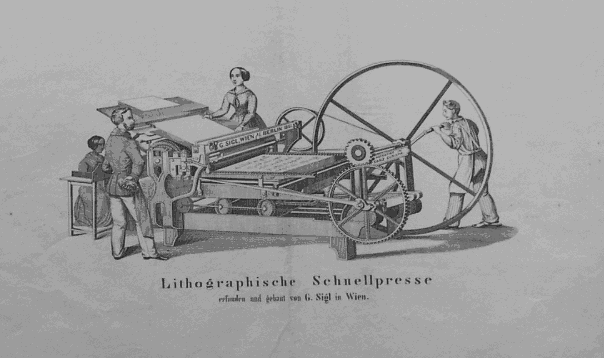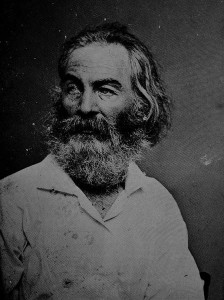Lithographing Kronos, Zeus his son, and Hercules his grandson,
Buying drafts of Osiris, Isis, Belus, Brahma, Buddha,
In my portfolio placing Manito loose, Allah on a leaf, the crucifix
engraved,
With Odin and the hideous-faced Mexitli and every idol and image,
Taking them all for what they are worth and not a cent more,
Admitting they were alive and did the work of their days,
(They bore mites as for unfledg’d birds who have now to rise and fly
and sing for themselves,)
Accepting the rough deific sketches to fill out better in myself,
bestowing them freely on each man and woman I see,
(“Song of Myself” 41.9–19, p 73–4 in the Library of America edition of Walt Whitman: Poetry and Prose, 1996)
As is illustrated throughout the David S. Reynolds cultural biography of Walt Whitman, printing and the publishing business was a significant factor in Whitman’s life, and in the lives of many people. He states, “Printing and distribution techniques improved immensely over the early decades of the nineteenth century” (Reynolds 45). For this reason, my image gloss is focusing on the word “lithographing” or, more specifically, lithography. From the Greek, lithography literally means to write on stone, which is quite descriptive of the process itself. Lithography is a form of printing that originally utilized stone in order to make prints, but later moved to metal plates, which were more economical. Invented by Alois Senefelder in 1798 in Austria (Jung para 2), lithography works through a method of ink-repulsion. Using an oil/ink resistant medium, such as gum arabic, wax, or other pliable substances, the image is drawn onto the stone or plate by the artist. Once the medium to repel the ink has set, the artist uses a large roller to spread ink onto the stone. The ink will only remain where there is a clear surface, free from the repelling medium. From here, the stone or plate is pressed to the paper and a print is created. Often the print was created in several stages in order to add depth to the image. While this process may seem primitive, “by1848 the process had been refined to the point that it was possible to print 10,000 sheers per hour” (Jung para 2). Lithography was/is considered an art in itself since it is not merely a matter of taking an image and Xeroxing it, but the image had to be recreated by hand. For this reason, mainly graphic images were printed using the lithographic process. Reynolds explains to the reader that “This [lithography] was how the famous 1855 portrait of Whitman would be produced” (Reynolds 282).
The fact that lithography was used to recreate images lends an interesting interpretation to this particular passage from “Song of Myself.” In creating lithographic images of these old gods and goddesses and gods of current religions, the speaker—the “I” as it is referred to in most articles—is making these images of intangible, ethereal beings, tangible and reproducible. In doing this, the speaker brings them down to the level of humanity and makes them available to everyone, “bestowing them freely on each man and woman [they] see” (Whitman 41.19). Essentially, the speaker of the poem takes the awe and fear out of faith and makes it something to be dealt with on a human level.

Lithographic Printing Press
Works Cited
Brady, Mathew B. “Portrait of Walt Whitman.” 1855. 15 Sep 2009. < http://www.usc.edu/schools/annenberg/asc/projects/comm544/library/images/477bg.jpg>
Jung, Marshall. “History of Lithography.” 19 Dec 2003. cartage.org, Web. 15 Sep 2009. <http://www.cartage.org.lb/en/themes/arts/graphicartists/Printmakingmethods/Planographicmethods/HistoryLithography/history.htm>.
Reynolds, David S. Walt Whitman’s America: A Cultural Biography. New York, NY: Vintage Books, 1996. Print.
Siǵl, G. “Lithoġraphische Schnellpresse.” Web. 15 Sep 2009. <http://www.jaapkruijff.net/uk/litho/machine.gif>
Whitman, Walt. “Song of Myself.” Walt Whitman: Poetry and Prose. Ed. Justin Kaplan. New York, NY: The Library of America, 1996. Print.


